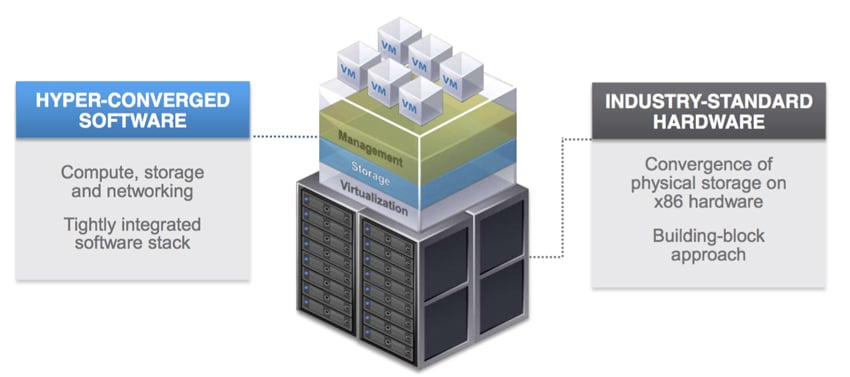![]() Today VMware Inc. is announced the latest version of its Virtual SAN (VSAN) enterprise-grade native storage for vSphere, version 6.2. Though the numbering is a bit confusing this actually marks the fourth-generation of VSAN. This new release is aimed at introducing new advanced data efficiency capabilities for all-flash storage, in addition to new Quality of Service (QoS) and performance and capacity monitoring capabilities.
Today VMware Inc. is announced the latest version of its Virtual SAN (VSAN) enterprise-grade native storage for vSphere, version 6.2. Though the numbering is a bit confusing this actually marks the fourth-generation of VSAN. This new release is aimed at introducing new advanced data efficiency capabilities for all-flash storage, in addition to new Quality of Service (QoS) and performance and capacity monitoring capabilities.
Today VMware Inc. is announced the latest version of its Virtual SAN (VSAN) enterprise-grade native storage for vSphere, version 6.2. Though the numbering is a bit confusing this actually marks the fourth-generation of VSAN. This new release is aimed at introducing new advanced data efficiency capabilities for all-flash storage, in addition to new Quality of Service (QoS) and performance and capacity monitoring capabilities.

VSAN is part of VMware’s hyper-converged software stack the other parts include VMware vSphere, and vCenter Server. VMware has become the software industry leader in HCI, for example: 21 months after first releasing VSAN they had over 3,000 customers. This is great news for VMware as IDC is predicted that the HCI market is set to grow $1.5 billion in revenue for 2016. VMware’s hyper-converged software stack combines compute, storage, and networking capabilities with off-the-shelf x86 hardware. This gives organizations a strong and cost-effective platform for managing their data. VMware also works with several partners to offer turnkey appliances, Ready Nodes.
As we’ve previously stated, VSAN main benefit is the simplification of storage and storage management, while delivering more performance. VSAN gives administrators visibility into the storage layer through the virtual layer. It enables both compute and storage to be delivered to the VMs through a common virtualized platform. VSAN can be setup as either hybrid or all-flash. In the hybrid setup the SSDs act as a cache. In the all-flash setup the SSDs act as both a cache and as data persistence enable overall better performance. VSAN is embedded in the vSphere kernel and optimized the I/O path to minimize the impact on CPU. Management is simplified as well. Administrators only need to create policies and assign them to VMs, VSAN automatically takes care of the rest and any changes will be applied by VSAN as well.
With the release of 6.2, VMware is making some pretty bold claims, that if past performance is any indication, they will most likely achieve them. VSAN 6.2 will help customers to achieve a more cost-efficient performance, improve support for any application, and accelerate time to value. VMware goes on to claim that is can offer customers an all-flash HCI system for as low as a $1 per usable GB and increased storage efficiency by up to 10x.
New features include:
- Deduplication and compression: Deduplication and compression optimizes all-flash storage capacity to provide as much as 7x data reduction with minimal impact on CPU and memory overhead.
- Erasure Coding (RAID5/RAID6): Erasure Coding helps increase usable storage capacity by up to 2x while maintaining the same high level of data resiliency.
- Quality of Service (QoS): New QoS capabilities will provide increased visibility, control and reporting of the IOPS consumed by each virtual machine helping to eliminate noisy neighbors.
VMware is also announcing new extensions for its Ready Nodes (servers from partners that are pre-configured to run VMware’s hyper-converged software stack). Currently VMware partners with 11 OEMs with over 100 certified systems for running VMware’s hyper-converged software stack. OEMs will now be able to factory install VMware vSphere and VMware Virtual SAN with certified drivers and firmware. This should in turn help customers see time-to-value. These new factory installed Ready Nodes will first be offered through Fujitsu and SuperMicro. Customers can also bundle these Ready Nodes with software licenses. The Ready Nodes are designed to help give customers more flexibility in deploying VMware’s hyper-converged software stack.
Availability and pricing
VSAN 6.2 is expected to be available in the first quarter of 2016 with a list price starting at $2,495 per CPU. VSAN for desktop carries a list price of $50 per user. New VSAN Ready Nodes are also expected to be available in the first quarter of 2016.
Sign up for the StorageReview newsletter

